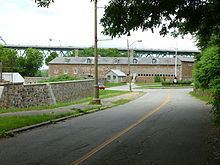Established 1955 | Type historical fort | |
 | ||
Location Montreal, Quebec, Canada Similar Musée Stewart, Saint Helen's Island, Hurtubise House, Church of St Michael and St A, The Fur Trade at Lachine | ||
The Fort de l'Île Sainte-Hélène, a historic site on Saint Helen's Island that belongs to the city of Montreal, Quebec, was constructed in the early 1820s as an arsenal in the defensive chain of forts built to protect Canada from a threat of American invasion. Although not heavily fortified, it served an important purpose as the central artillery depot for all forts west. These included Fort Henry and Fort Lennox. The red stone used to build the Fort is a breccia quarried on the island, which is situated in the St. Lawrence River between the island of Montreal and the south shore.
Contents
The Levis Tower, contrary to popular belief, was not part of the fortifications on the island. It was built in the 1930s to house a water tower.
History
Built in 1820-1824 by the British, the fort served as arsenal and a storage facility for weapons and equipment. It was transformed into a military prison after the rebellions of 1837. The complex was however ravaged by fire in 1848, only to be rebuilt in 1863-1864.
After the British Army left the fort for ruin, it became part of the City of Montreal. In the 1930s, it was restored as part of a job creation project during the Great Depression. During the Second World War, it was used as an internment camp for Italian Canadians. During the summer months the Fort houses two reconstituted 18th century regiments, The Olde 78th Fraser Highlanders, and Les Compagnies Franches de la Marine.
Today the Fort is also home to the David M. Stewart Museum, an institution founded in 1955 to collect, store and display historical artefacts from Canada's colonial past, particularly that of New France. The museum collections include artefacts dating from the 16th century through to the 19th century. Both the Fort and the museum are open year-round.
David M. Stewart Museum
The museum, housed inside the garrison, features a permanent exhibition and an annual one, usually open in the spring months. During the summer months, the museum plays host to reconstituted 18th century regiments that perform daily military maneuvers. The regiments, the Olde 78th Fraser Highlanders and Les Compagnies Franches de la Marine perform daily musket drills, fife and drum and bagpipe shows. A 19th century Royal Artillery regiment, the 4th brigade, is planned to be added. In 2011, the museum underwent significant renovations indoors that also resulted in the addition of a glass staircase and elevator to access the three floors of the museum.
The noon day gun salute is a tradition that was originally undertaken by British troops stationed at the fort. It acted as a form of synchronization for the city. The cannon fire signaled noon solar time. This tradition had been continued by museum staff dressed in the regimental dress of the Royal Artillery until the museum underwent renovations; it is uncertain whether the tradition will return.
Prior to the renovations, an encampment had also been set up next to the parade square simulating 18th century colonial life in New France. Bread was baked in a wood-fired oven daily as well as children's crafts and games were set up to give a hands-on approach to education of life during the 18th century. The encampment, as the noon day gun, may not return as a result of regulations of Parc Jean Drapeau rules against fires such as those used by the baker in the encampment.
